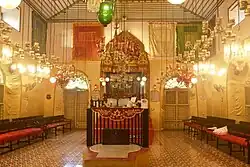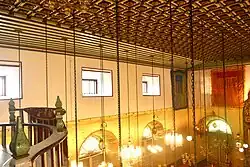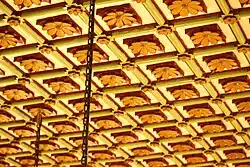Kadavumbhagam Ernakulam Synagogue
The Kadavumbhagham Ernakulam Synagogue is the restored oldest synagogue of the Malabar Jews, with a Sefer Torah scroll and offering occasional services.[1] It was established in 1200 CE and restored several times through the centuries on the same site.[2][3] It is modeled on the earliest synagogue of the Malabar Jews at Muziris from the ancient times of Mediterranean sea trade with Kerala. The earliest synagogue of the ancient Malabar Jews is today submerged in the sea following the gradual rise of sea level over several millennia. Although the Chendamangalam Synagogue is the oldest surviving synagogue structure in Kerala and the Indian subcontinent (established in 1166 CE), its Torah scrolls were taken to Israel by it congregation in 1952. This makes the Kadavumbhagham Ernakulam synagogue the oldest Malabar Jewish synagogue today (since its restoration in 2018) with a Torah scroll that is occasionally used for services.[4] The Paradesi Sephardic synagogue at Mattancherry also has Torah scrolls but it was established much later in 1568 CE.


Background

Several millennia of contact and sea trade between Malabar Jews and local traders in Kerala has led to immense cultural exchange between communities. Jewish traders travelled between the Mediterranean region and Kerala in sea vessels similar to uru boats, a type of dhow that is even today made in Beypore, Kerala, in the southwestern coast of India.[5][6]
The Malabar Jews who settled since the times of King Solomon have intermingled with the natives and share linguistic and cultural aspects with the local people. While the Sephardic Jews that arrived in 1568 have maintained a distinct identity since they are recent arrival. Some of the cultural similarities and exchanges between Malabar Jews and Kerala locals can be seen in language use. For instance 'Tuki' refers to "peacock" in Tamil, corresponding to 'Tukyim' in Hebrew. Likewise in Hebrew 'Metta' refers to "mattress" and 'Metta' is also used to refer to mattress in Malayalam spoken by Kerala Nasrani Syrian Christians of Kerala.
History

In ancient times, the port of Muziris served as a trading hub between the Levant (Israel, Phoenicia, Rome) and Kerala.[5][6] This allowed the Kerala port of Muziri (Muchiri) to become the hub of continental trade between the Mediterranean world and Kerala.[6] The Kadavambhagam synagogue belongs to the diaspora of Jews who settled in Kerala during the Sangam period when black pepper was a chief commodity being traded, used as preservative for food and other purposes.[6] A West Asian trading post emerged in the ancient Muziris region as mentioned in the Periplus of the Erythraean Sea written by a "Greek in Egypt, a Roman subject" as described by the translator Wilfred Harvey Schoff (1912).[5]
Early modern period

By the 1300s CE Arab traders had settled in the areas under the control of the Zamorin. This earned the Zamorin significantly more taxes from the larger Arab trading population than the smaller Jewish community. As the Arabs gained more prominence in Kozhikode, the Jewish population began to leave or integrate with the Arabs in the Kozhikode region of the Zamorin. Even today there is a Jew Street in Kozhikode.[7]
Later Jewish settlements moved to further inland regions from Muziris. These settlements were at Chendamangalam synagogue, Paravur Synagogue (Paravur Jew Town and Paravur Jew Street) and the Kadavambhagham Ernakulam synagogue. The oldest tombstone from this community – the tombstone of Sarah Bet Israel – is today to be seen in the Chendamangalam Jewish cemetery near the Chendamangalam Jewish Synagogue. This is the oldest tombstone in all of the Indian subcontinent and dates back from around the time of the founding of the Chendamangalam Synagogue in 1166 CE.[8]
Through the 1200s CE a south-side synagogue (Thekkumbhagar synagogue) and a coast side-river harbour side synagogue, the Kadavumbhagam synagogue, was created in Mattancheri and similarly another set of ‘South-side’, Thekkumbhagar Synagogue, and Coast side-river harbour synagogue, Kadavambhagam synagogue, was also built in Ernakulam. Thus there are two pairs of Thekkumbhagam synagogue and Kadavambhagam synagogue, one pair in Mattanchery and another in Ernakulam. All these synagogues are essentially built as continuations of the synagogue in Muziris.
The present-day Kadavumbhagam Ernakulam synagogue site is from 1200 CE, although the structure is renovated. The Jewish settlement of Malha followed and a synagogue was established in Mala around 1200 CE as well. This synagogue site still exists and has one of the largest graveyards in India spread across four acres. Today the present day Paravur Synagogue, Paravur Jew Town and Paravur Jew Street, and the Chendamangalam Synagogue and Chendamangalam Jewish cemetery are all part of the Muziris heritage project.
The Sephardic Jews later came in the 16th century and made a Sephardic synagogue near the Kadavambhagam synagogue at Mattancherry. This Sephardic synagogue is today known as the Mattancherry Paradesi Synagogue and was built in 1568.
Early Muziris

Periplus of the Erythraean Sea, writing around the 3rd century BCE, discusses the Malabar coast as Limyrike.[5] Periplus of the Erythraean Sea (53:17:15-27) mentions Limyrike to begin from Naura (Kannur) and Tyndis (Cerobothra, north of Muziris) which corresponds to modern day Malabar coast where Jews had settled as traders in the town of Muciri - and generally along the Malabar coast - since the time of King Solomon.[5][6] Periplus also mentions Nelcynda (today identified as Nakkada near Niranam in Pathanamthitta district) which was once the capital of Ay Kingdom in ancient times.[5][6] Early Jewish settlements existed in Muziris (present day Pattanam in Kochi near North Paravur) and also at Palayur with ruins of an ancient synagogue. An early Nasrani Palli was established along the Jewish settlement of Paloor (Palayur) as well. The settlement of Paloor is mentioned in the Kerala Nasrani Syrian Christian Ramban song as well as Malabar Jewish songs.[9][10][11][12] Old Malabar Jewish songs mentions Paloor as an important congregation for Jewish tradition in the Malabar coast of Kerala with a synagogue.[13] The ancient Malabar Jews were present all along the Limyrike through Kollam, Alappuzha, Kottayam, Ezhimala, Pandalayini, and most of all in Muziris. An ancient synagogue was said to have existed in Muziris. This synagogue is now believed to be submerged due to gradual rising sea level over the millennia.
.jpg.webp)
Several waves of Jews migrated from the Levant to the Malabar Coast of Kerala. The migration began from 722 BCE after the Assyrian conquest of Israel; further waves were recorded after the destruction of the First Temple by Nebuchadnezzar II, the fall of the Second Temple in 70 CE, the fall of the Bar Kokhba revolt and then subsequent attacks on the Jewish communities by various groups. The last significant migration from the Levant was after the Spanish inquisition in 1492 CE.
The earliest Jewish groups that settled in the Malabar coast of Kerala since the time of King Solomon of the Old Testament are called as 'Malabar Yehudan' (Malabar Jews) and form the original core population of the Cochin Jews. The last group of Spanish Jews that came a few hundred years ago are called Paradesi Jews. Thus there are two main groups of halakhic Cochin Jews – the ancient group of early Jewish settlers and the latter group of European Jewish settlers in Kerala.
The Cochin Jews were granted copper plates of rights by the local ruler of Kerala.[15] This is said to have taken place in the third century CE where in 72 privileges were granted on copper plates.[15] The copper plates were privileges that enabled the formation of a trading guild called "Anjuvannam".[15] The Hebrew inscriptions on the copper plates is taken as evidence of the presence of Jews in Kerala since antiquity,[16][17][18] a conclusion strengthened by Kerala's Nasrani Syrian Christians, who share a common heritage with the Cochin Jews.
Incidentally, the copper plates that belong with the Kerala Nasrani Syrian Christians has the oldest Hebrew inscriptions in Kerala and India.[18] These copper plates have old Malayalam inscriptions and also have signatures in Hebrew, Kufic, and Pahlavi.[17][18] Hence the Kerala Syrian Christian copper plates are taken as the oldest evidence of the presence of Jews in Kerala and India.[18] In the paper ‘Kerala and Her Jews’, published by Cochin Jewish Synagogue (1984), the Cochin Jewish writers Fiona Hallegua and Shabdai Samuel Koder wrote: "...the Syrian Christian (copper) plates with the signature of four Jewish witnesses in Judeo - Persian, which incidentally is the second oldest inscription in Judeo-Persian in the world, are a few of the ancient relics that can still be seen to remind one of the glorious past of this forgotten outpost of the Jewish world."[10]
In 2017 the Israeli government enshrined a replica of the Kerala Malabar Nasrani Syrian Christian Copper plates in the Israel Museum in Jerusalem.[14] A plaque was installed citing that the Hebrew inscriptions on the Kollam copper plates from the Mar Thoma Syrian Church, in Thiruvalla, in Kerala is the oldest evidence of the presence of Jewish people in Kerala and India.[14]
Malabar Cochin Jewish congregational music is in the Organum style of music.[19][20][21] Even today the song "Yigdal Elohim Chai" has the same tune in Yemenite Jewish tradition and Malabar Jewish tradition.[19][20][21]
Present day

The Kadavumbhagham Mattancherry synagogue is in ruins. However, the Kadavunbhagham Ernakulam synagogue was restored in 2018. The Sabbath services at the Kadavumbhagam Ernakulam synagogue continued till 1972 when a large portion of the community immigrated to Israel by 1972 along with the Torah scrolls.[7] For decades, the Kadavumbhagham Synagogue at Ernakulam remained without any Sabbath services and without a Sefer Torah. Today the synagogue is nested within the bustling market at Ernakulam with a thriving aquarium in the front area near the synagogue operating since 1985. After much effort, the Kadavumbhagham Ernakulam synagogue was restored and the Sefer Torah brought back to the synagogue in 2018 after 46 years.[1] Today only two synagogues in Kochi have Torah scrolls: the Paradesi synagogue of the Sephardic Jews in Mattancherry, and the Kadavumbhagham Ernakulam synagogue of the ancient Malabar Jews.
Architecture

The synagogue's ceiling is decorated with intricate carvings. The women's section is located in the balcony area; like many orthodox Jewish synagogues, the synagogue has separate seating for men and women.[22] The Kadavumbhagham Ernakulam synagogue has a bimah and a much decorated Torah ark that is made from wood and is typically plated with precious metal like gold or silver. This houses the Torah scrolls.[23] The ark constitutes the Holy of Holies that is separated only by a parokhet, or curtain.[24] The synagogue also has a sanctuary lamp, suspended from the ceiling at the centre of the sanctuary.[25]
Notes
- "Kochi: 818-year-old synagogue reopens, devotees welcome 'Sefer Torah'".
- Waronker, J A. (2010) 'The Synagogues of Kerala, India: Their Architecture, History, Context, and Meaning'. Cornell University. page 247, chapter 15
- Waronker, Jay A. "Kadavumbagam Synagogue, Ernakulam".
- "Kochi Jew fulfills dream to revamp old synagogue". 24 June 2019.
- Periplus Maris Erythraei "The Periplus of the Erythraean Sea", (trans). Wilfred Schoff (1912), reprinted South Asia Books 1995 ISBN 8121506999
- Miller, J. Innes. (1969). The Spice Trade of The Roman Empire: 29 B.C. to A.D. 641. Oxford University Press. Special edition for Sandpiper Books. 1998. ISBN 0198142641.
- "Kadavumbagam Synagogue". Synagogues360. Retrieved 5 November 2022.
- "India: Minor Synagogues of Kerala - Yahweh's own country". Retrieved 5 November 2022.
- Zacharia, Paul (19 February 2016). "The Surprisingly Early History of Christianity in India". Smithsonian Journeys Travel Quarterly.
- Hallegua F. & Koder S. (1984) ‘Kerala and Her Jews’, published by Cochin Jewish Synagogue). Pages 1-3
- Weil, Shalva (1982). "Symmetry between Christians and Jews in India: The Cananite Christians and Cochin Jews in Kerala". Contributions to Indian Sociology. 16 (2): 175–196. doi:10.1177/006996678201600202. S2CID 143053857.
- "India Has a Long History of Native Christianity". Opinion. The New York Times. 22 February 1986. ISSN 0362-4331. Retrieved 5 November 2022.
- Scaria Zacharia and Ophira Gamliel, (2005) Karkulali—Yefefiah—Gorgeous!: Jewish Women's Songs in Malayalam with Hebrew Translations, Jerusalem: Ben-Zvi Institute, ed. and trans
- "Kerala Jewish and Kerala Syrian Christian Copper plate Replicas in Israel Museum". The Hindu. 5 July 2017.
- Weil, Shalva (1982). "Symmetry between Christians and Jews in India: The Cananite Christians and Cochin Jews in Kerala". Contributions to Indian Sociology. 16 (2): 184–186. doi:10.1177/006996678201600202. S2CID 143053857.
- "Indian characters but a Jewish sensibility". The Times of Israel.
- Weil, Shalva (1982). "Symmetry between Christians and Jews in India: The Cananite Christians and Cochin Jews in Kerala". Contributions to Indian Sociology. 16 (2): 187. doi:10.1177/006996678201600202. S2CID 143053857.
- Gamliel, O. (2018) Back from Shingly: revisiting the pre-modern history of Jews in Kerala, Indian Economic and Social History Review, 55(1), pp. 53-76
- Spector, Johanna (1970) "Yemen" in Encyclopedia Judaica, 16:749-759.
- Spector, Joanna (1973) "Problems in the Study of Singing Traditions in the Music of the Jews," in Hagut Ivrit Ba'Amerika, Vol. 2.Israel: Brit Ivrit Olamit.
- Ross, Israel J. (1979) Ritual and Music in South India: Syrian Christian Liturgical Music in Kerala (pp. 80-98). vol 11, no 1. DOI: 10.2307/833968
- Waronker, J A. (2010) 'The Synagogues of Kerala, India: Their Architecture, History, Context, and Meaning'. Cornell University. Page 28
- Waronker, J A. (2010) 'The Synagogues of Kerala, India: Their Architecture, History, Context, and Meaning'. Cornell University. Page 23
- Waronker, J A. (2010) 'The Synagogues of Kerala, India: Their Architecture, History, Context, and Meaning'. Cornell University. Page 28 and page38
- Waronker, J A. (2010) 'The Synagogues of Kerala, India: Their Architecture, History, Context, and Meaning'. Cornell University. Page 84
Further reading
- Koder, S. "History of the Jews of Kerala", The St. Thomas Christian Encyclopaedia of India, ed. G. Menachery, 1973.
- Puthiakunnel, Thomas. (1973) "Jewish Colonies of India Paved the Way for St. Thomas", The Saint Thomas Christian Encyclopedia of India, ed. George Menachery, Vol. II., Trichur.
- Daniel, Ruby & B. Johnson. (1995). Ruby of Cochin: An Indian Jewish Woman Remembers. Philadelphia and Jerusalem: Jewish Publication Society.
- Menachery, George, ed. (1998) The Indian Church History Classics, Vol. I, The Nazranies, Ollur, 1998. ISBN 81-87133-05-8
- Katz, Nathan; & Goldberg, Ellen S; (1993) The Last Jews of Cochin: Jewish Identity in Hindu India. Foreword by Daniel J. Elazar, Columbia, SC: Univ. of South Carolina Press. ISBN 0-87249-847-6
- Menachery, George, ed. (1973) The St. Thomas Christian Encyclopedia of India B.N.K. Press, vol. 2, ISBN 81-87132-06-X, Lib. Cong. Cat. Card. No. 73-905568 ; B.N.K. Press